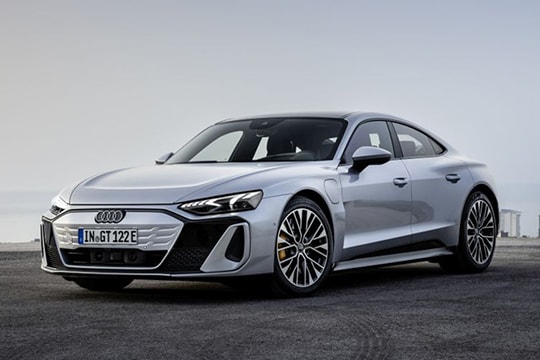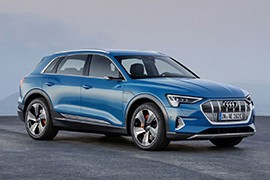AUDI e-tron Models/Series Timeline, Specifications & Photos
First production year: 2019
Engines: Plug-in hybrid, Electric
Body style: SUV (Sports Utility Vehicle)
Audi introduced the e-tron GT lineup in 2020 as an all-electric sports car, and after a few updates it received a significant upgrade in 2024 when it launched three versions for the same vehicle.
Audi introduced the e-tron nameplate in the late 2000s for its electrified vehicles, and it wasn’t until 2019 that the automaker launched its first all-electric e-tron model, the e-tron SUV. While some customers were willing to drive the all-electric crossover, others were still waiting for a sportier version of the car. Their wait wasn’t in vain since Audi introduced the 2020 e-tron GT on the same platform as the Porsche Taycan. Despite all the problems caused by the world pandemic and the microchip crisis, this all-electric four-door sports car from the four-ring brand sold well. As a result, the car manufacturer decided to give it a major boost in 2024 when it launched it in three: the S e-tron GT, the RS e-tron GT, and the RS e-tron GT performance.
With its futuristic, aggressive look, the 2025 e-tron GT featured angular-shaped headlights that covered the matrix-LED blocks. These were adorned by daytime running lights. Audi installed a reversed singleframe grille that covered almost the entire front fascia of the car. This was flanked on the lower sides by black oblique trims and side scoops that helped the four-door grand tourer get a better drag coefficient via the air curtains.
From its profile, the low-slung four-door GT featured a panoramic windshield followed by a curved roof and a sloped-down tailgate. The look of the muscular fenders was emphasized by creased lines extended over the doors, while behind the front wheel arches, the automaker placed exhaust vents that released the air trapped in the wheel wells to decrease lift forces. Furthermore, the side sills were designed to reduce the ground effect. Out back, the broad taillights emerged from the quarter panels onto the trunk's lid, with arrow-like LED shapes pointed inwards and connected via a luminescent stripe. A subtle and elegant hexagonal shape left room for the license plate and echoed the singleframe grille at the front. Finally, on the lower side of the bumper, Audi placed a broad diffuser that increased downforce.
Inside, the high-tech era was present even in the 2020 model year, but Audi thought it could do more. The infotainment system, known as the MMI in Audi’s language, featured a setting for the RS e-tron performance that showed a white power display and speedometer resembling the analog dials of the 1994 Audi RS 2 Avant. Besides the infotainment’s touchscreen, the automaker also installed a screen in front of the driver for the main driving information. The high-bolstered front seats were standard and promised customers a firm grip during high-speed cornering. In the back, the bench seat was profiled for two passengers and provided limited legroom. Customers could opt for a panoramic glass roof that minimized direct sunlight and turned into opaque mode at the touch of a button.
Under its skin, the e-tron GT was available in three power levels. The S e-tron GT provided 671 PS (662 hp), the RS e-tron GT version came with 845 hp (833 hp), and the mighty RS e-tron GT performance brought 912 PS (900 hp) to the performance table. Regardless of the version, all came with the same 107 kWh battery that promised a range of up to 378 miles (609 km). Thanks to its 800-volt technology, the car could charge enough juice in 10 minutes for 280 km (174 miles).
The e-tron was the first fully electric car built by Audi. It was shown as a concept car at the 2015 Frankfurt Motor Show. The first cars were delivered in 2019.
In the quest for green motoring, some car-makers build their electric vehicles to look like a statement. Tesla Model-X or Jaguar E-Pace were designed to look different. On the other hand, the e-tron took a different path. It was built on an existing platform in a shape that was already known for customers who didn't want to prove anything special.
The front fascia of the e-tron was dominated by the big singleframe grille. Even though electric cars need cooling for the motors and the batteries, they don't need the same big radiators. But the singleframe was still in place. It was painted in titanium-gray, which became a trademark for Audi's electrified models. On the sides, the car featured an option for two slim side-arms for rear-view cameras, instead of rear-view mirrors. The e-tron was equipped with a full LED light system for headlights and taillights.
Inside, the e-tron offered only seating for five. It featured only digital displays for the instrument cluster, infotainment system, and two smaller screens on the doors for the rear-view cameras. It featured Valcona leather seats and natural wood inserts in the cabin, to enhance the luxury experience.
The e-tron featured two electric motors, one for the front and one for the rear axle. The 95kWh and 700 kg (1543 lbs) battery pack was placed between the axles, in the floor. It was available with either a 120 kW charging system or 150 kW, while a standard 9.6 kW AC (11 kW AC for Europe) capsule charger was provided and designed to deliver a fresh charge overnight.

